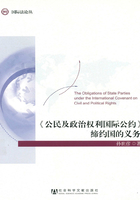
第二章 缔约国义务的形式
《公约》第2条第1款规定,《公约》缔约国有义务“尊重和保证”(to respect and to ensure)个人的由《公约》所承认的权利。因此,“尊重”和“保证”是缔约国根据《公约》承担的义务的基本形式。
在分析缔约国根据人权条约所承担的义务或一般意义上国家在人权方面的义务时,学者往往从义务层次入手。这种对国家人权义务层次的分析首先是从探讨与经济、社会和文化权利相对的国家义务开始的。 挪威人权学者阿斯伯约恩·艾德很早就提出了国家人权义务的三个层次,即“尊重的义务”(obligations to respect)、“保护的义务”(obligations to protect)和“实现的义务”(obligations to fulfill)。
挪威人权学者阿斯伯约恩·艾德很早就提出了国家人权义务的三个层次,即“尊重的义务”(obligations to respect)、“保护的义务”(obligations to protect)和“实现的义务”(obligations to fulfill)。 当时,这一义务层次的理论是针对食物权提出的,随后很快被用于分析作为整体的经济、社会和文化权利,
当时,这一义务层次的理论是针对食物权提出的,随后很快被用于分析作为整体的经济、社会和文化权利, 并且扩展到四个层次,即将“实现的义务”分解为“保证的义务”(obligations to ensure)和“促进的义务”(obligations to promote)。
并且扩展到四个层次,即将“实现的义务”分解为“保证的义务”(obligations to ensure)和“促进的义务”(obligations to promote)。 这种义务层次的分析方法后来被扩展为适用于所有的人权,即同时适用于经济、社会和文化权利以及公民权利和政治权利。
这种义务层次的分析方法后来被扩展为适用于所有的人权,即同时适用于经济、社会和文化权利以及公民权利和政治权利。 不过,由于这种方法首先并主要是在分析经济、社会和文化权利以及这一类权利与公民权利和政治权利之异同的语境中发展出来的,因此专门以之对公民权利和政治权利进行的分析并不多见。
不过,由于这种方法首先并主要是在分析经济、社会和文化权利以及这一类权利与公民权利和政治权利之异同的语境中发展出来的,因此专门以之对公民权利和政治权利进行的分析并不多见。 人权事务委员会也没有像经济、社会和文化权利委员会那样,在其一般性意见中明确使用义务层次的说明方法。就《公约》而言,学者更多的是从其第2条第1款本身使用的两个概念即“尊重”和“保证”出发来进行分析的。
人权事务委员会也没有像经济、社会和文化权利委员会那样,在其一般性意见中明确使用义务层次的说明方法。就《公约》而言,学者更多的是从其第2条第1款本身使用的两个概念即“尊重”和“保证”出发来进行分析的。 例如,曼弗雷德·诺瓦克就没有直接使用“义务层次”的概念,但将《公约》规定的缔约国义务分为“尊重”的义务和“保证”的义务,其中保证的义务包括“保护”的义务和“实现”的义务,实现的义务又分为“促进”的义务(obligations to facilitate)和“提供”服务的义务(obligations to provide services)。
例如,曼弗雷德·诺瓦克就没有直接使用“义务层次”的概念,但将《公约》规定的缔约国义务分为“尊重”的义务和“保证”的义务,其中保证的义务包括“保护”的义务和“实现”的义务,实现的义务又分为“促进”的义务(obligations to facilitate)和“提供”服务的义务(obligations to provide services)。 联合国人权事务高级专员办事处在其有关《公约》和人权事务委员会的第15号《人权概况介绍》中,提出缔约国的义务分为三个部分,即“尊重”的义务、“保护”的义务以及“促进”或“实现”的义务。
联合国人权事务高级专员办事处在其有关《公约》和人权事务委员会的第15号《人权概况介绍》中,提出缔约国的义务分为三个部分,即“尊重”的义务、“保护”的义务以及“促进”或“实现”的义务。 可见,无论是根据诺瓦克的分析,还是《人权概况介绍》的总结,缔约国根据《公约》第2条第1款承担的义务都可以基本分为“尊重的义务”、“保护的义务”以及“促进和实现的义务”三个方面。除此之外,根据《公约》第2条第3款,缔约国还承担着一种“救济的义务”。
可见,无论是根据诺瓦克的分析,还是《人权概况介绍》的总结,缔约国根据《公约》第2条第1款承担的义务都可以基本分为“尊重的义务”、“保护的义务”以及“促进和实现的义务”三个方面。除此之外,根据《公约》第2条第3款,缔约国还承担着一种“救济的义务”。
由于《公约》规定的权利和国内法中的“权利法案”非常类似,因此,在探讨缔约国根据《公约》对个人承担的义务之前,首先需要分析在最一般的意义上国内法保障人权的方式和特点,然后再以之为对照,分析缔约国根据《公约》承担的义务的形式。在《公约》缔约国承担的义务方面,还涉及一个问题,即当《公约》于缔约国领土外适用时,如何履行义务的问题。这一问题将在第五章有关缔约国在《公约》之下义务的属地范围的第六部分中分析。